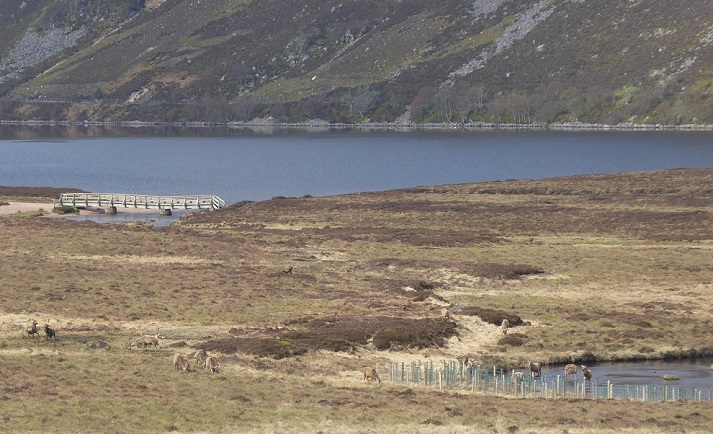
I had always intended to include the Royal Sporting Estate at Balmoral in my series on Deer Density in the Cairngorms (see here) after a walk round the upper part of Glen Muick in May. However, I followed that up with a further Freedom of Information request on current deer numbers at Caenlochan (see here). While NatureScot responded in early July, providing lots of information which should have been in the public realm, I have not found time to write about that or my visit until now.
Deer density on the main part of Balmoral
Heading for Loch Muick from the Spittal of Glen Muick car park it did not take us long to spot a small herd of red deer grazing on the flats (see above). On our return in the afternoon there was a larger herd grazing the best ground just a couple of hundred metres from the car park:
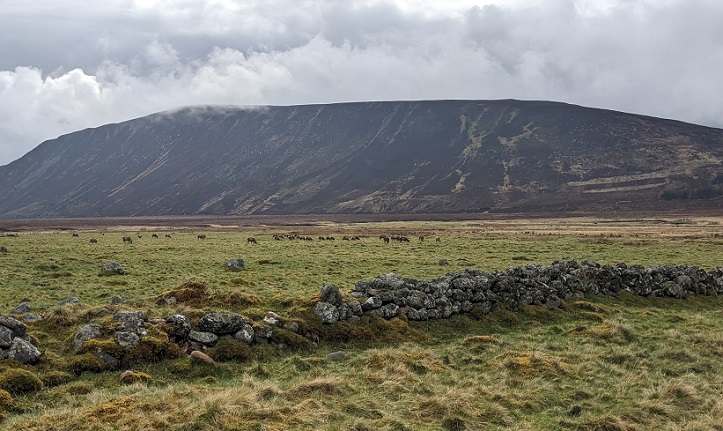
That the deer were not bothered by human presence – there were lots of other people around – suggests that Balmoral may not have taken advantage of the change in the law last year which now allows stags to be shot year round. While the herds I saw were much smaller than those I saw on the Quoich flats near Mar Lodge that same week, it is difficult to assess their significance because of the lack of information that is publicly available on deer numbers for the main part of Balmoral.

The main part of Balmoral is part of the South Deeside and North Angus Deer Management (SDNADMG) but Bachnagairn, which was subject to the Section 7 Agreement designed to reduce the very high numbers of deer numbers at Caenlochan, is now part of the South Grampian Deer Management Group (SGDMG).
Unlike the SGDMG website, which contains up-to-date information on deer management for the area it covers, the last minutes of a meeting from the SDNADMG website (see here) dates from April 2017 while the Deer Management Plan 2016-20 appears never to have been updated. There are no dates on the SDNADMG Action Plan, 2016-20 and it is unclear when it was last updated but, whenever that was, many of the agreed actions had not been started:
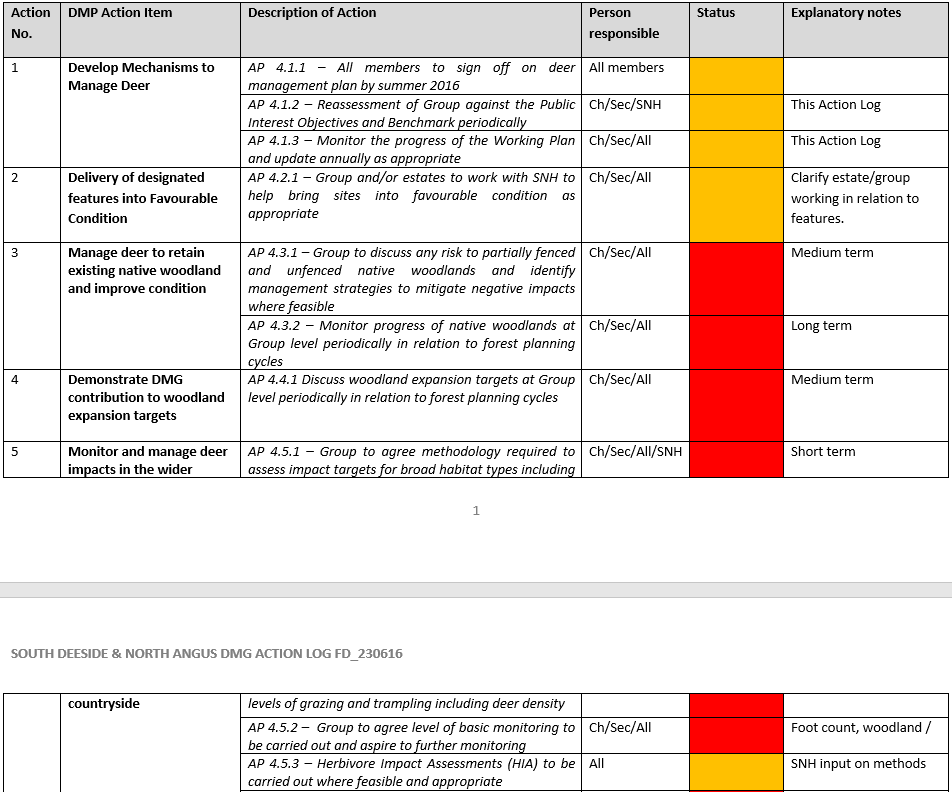
As the owner of the largest single landholding in the SDNADMG, King Charles bears a high degree of responsibility for this failure by the Deer Management Group to report what is or is not going on. Indeed, according to the Deer Management Plan and accompanying Action Plan (point 5), the various landholdings appear not even have been able to agree a target for deer density. That is despite deer density having been reported for Balmoral in the past. In 2010 the Deer Commission did a helicopter count and reported (see here) red deer numbers at Balmoral as follows:

While in 2010 deer numbers for the main part of Balmoral, which includes lots of fenced woodland, met NatureScot’s current and far too high target of 10 deer per square kilometre, three years later the factor at Balmoral, Richard Gledson, was reported by the Press and Journal (see here) to have said deer numbers were “12 – 14 per square kilometre as opposed to 20” twenty five years previously.
Red Deer of course are notoriously difficult to count but it says something that neither NatureScot nor the Cairngorms National Park Authority (CNPA) appear to have done anything to force the Royal Family to report publicly on deer numbers and culls on the main part of Balmoral. (Further FOI requests to follow).
The impact of deer on the south side of Glen Muick
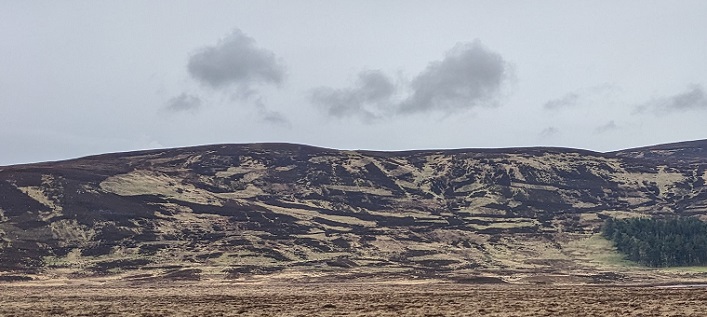
In considering the impact of red deer in Glen Muick, it is important to emphasise that the Royal Family is managing the land for BOTH grouse and deer. This can be seen as one is driving up the glen to the Spittal of Glen Muick. These “sporting objectives” constrast with Delnadamph, on Donside, where King Charles has eliminated deer almost entirely in favour of grouse (see here) and most of the grouse moors in South Angus which have done the same.
While the burning of heather promotes grass growth initially, potentially providing better browsing for deer for a time, it also destroys plants, including trees, that do not tolerate fire. That considerably complicates questions about the impact of deer in the open parts of the glen: whether deer density is 2 or 20 if much of the land is burned the consequences for plants vulnerable to browsing or fire will be the same.
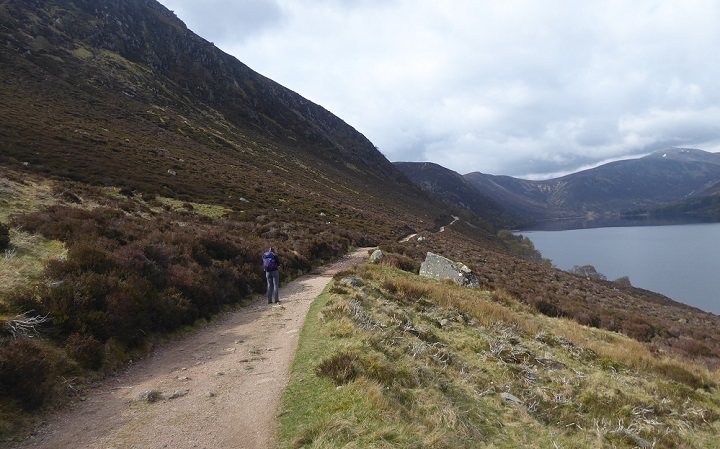
Given the steep sided slopes and well drained ground, woodland would naturally regenerate ialong most of the south shore of Loch Muick if it wasn’t for burning and browsing.

Indeed, a little further on where the burning stopped the heather was profuse and we started to see saplings everywhere despite an absence of fencing. The explanation probably lies in the natural instinct of red deer to avoid areas where they might become trapped, such as between this steep slided slope and the loch, unless driven by hunger. If deer numbers have halved on this part of Balmoral, as Richard Gledson has claimed, that would explain why trees are now naturally regenerating on the more accessible ground below the crags.
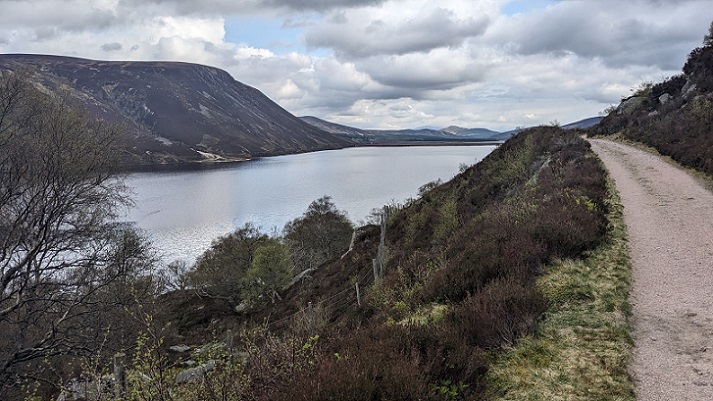
The fenced enclosure near the Black Burn provided evidence to support that interpretation of what has happened. When deer numbers were higher a fence was necessary to protect trees but now the population has reduced somewhat there is natural regeneration on both sides of the (unmarked) fence making it effectively redundant.
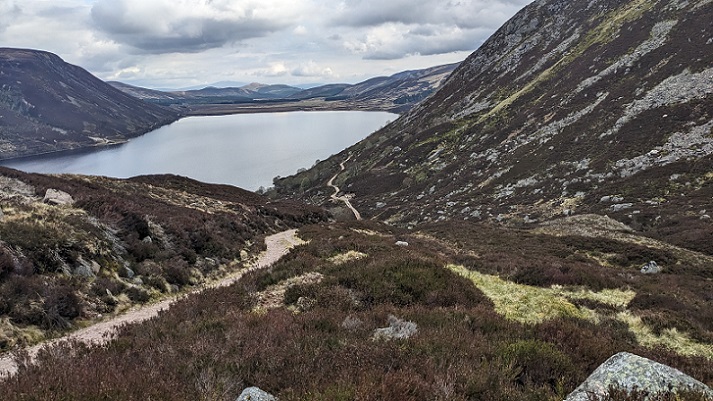
Where the track started to rise up to the plateau above there was profuse natural regeneration of trees but that soon came to a halt because of muirburn. Were the burning to stop much of the steep sided glen by the Black Burn – an extension of the “deer trap” – might now be evolving into woodland.
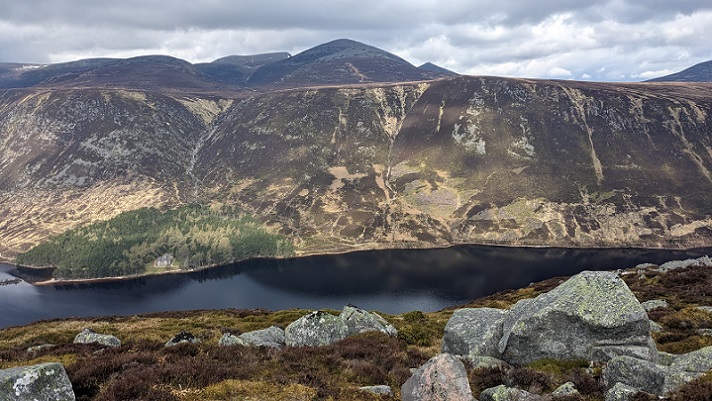
Where the track emerged onto the plateau, almost opposite Glas-allt-Shiel, appeared to mark the boundary of the area burned for grouse. From here, over the plateau to Broad Cairn and Carn Bannoch and then back down to Loch Muick, the royal influence on the vegetation has been driven by wanting to maintain high numbers of deer, rather than high numbers of grouse, for sporting purposes.
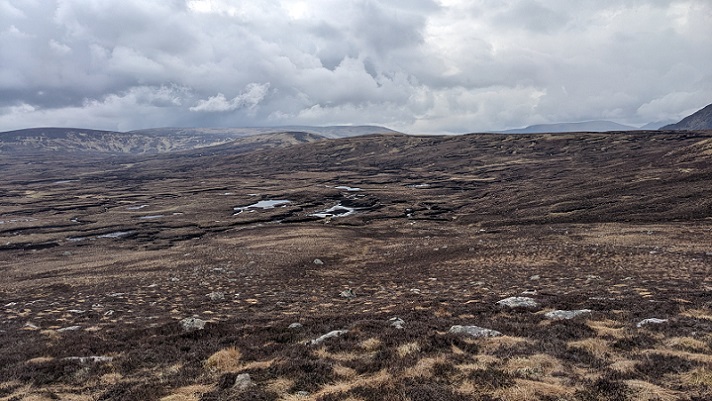
Unfortunately, once on the plateau storm clouds started to gather and we decided not to go over to look at the bare peat to check the extent to which deer trampling might have been responsible for eroding it. From a distance, however, the erosion of this bog appeared far greater than could be accounted for those other agents of peatland erosion, gravity and water.
Bachnagairn

Unpublished habitat assessment reports, released by NatureScot in response to my two information requests on Caenlochan, contain extensive evidence about the impact of high deer numbers on the Caenlochan Special Area of Conservation part of which falls within the royal land at Bachnagairn. However, at the end of winter and before the first flush of new spring vegetation on the higher ground, it was difficult to tell whether Bachnagairn was any more grazed than much of the rest of Balmoral or many other parts of upland Scotland.
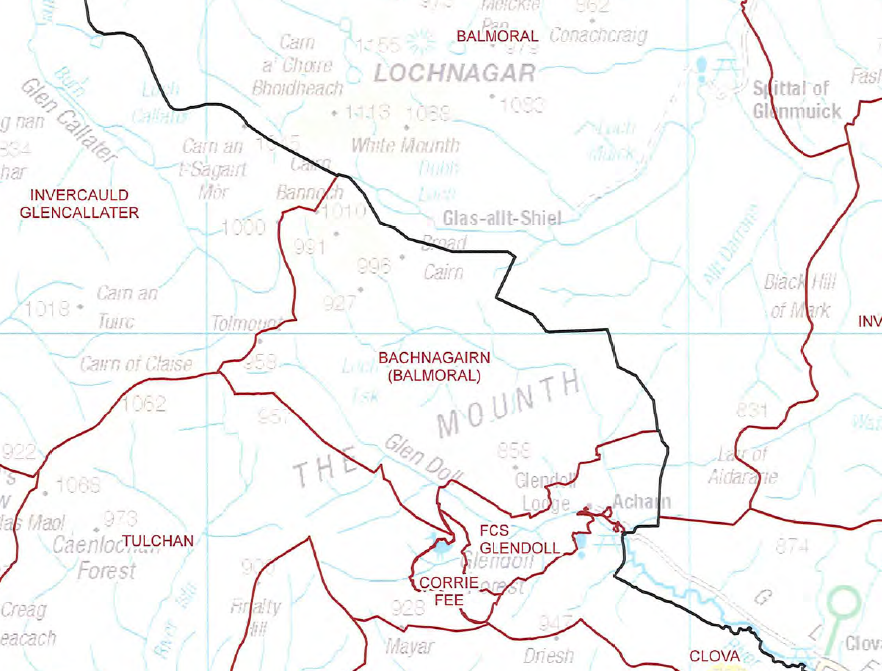
There were, however, landscape scale signs of trampling and grazing pressure such as the paucity of plant species, including a general absence of cladonia lichens which have resurged in Glen Feshie and on the conservation half of Mar Lodge since deer density has been reduced to less than two per square kilometre.
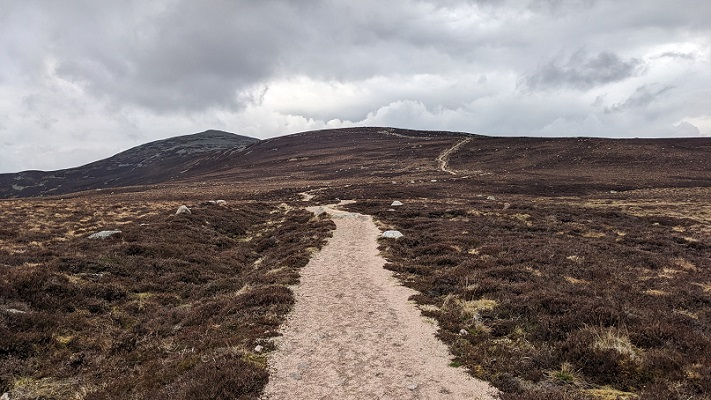
What should be obvious at the end of winter, however, is that this high ground is unlikely to offer very much for large herbivores to eat even at the height of summer:
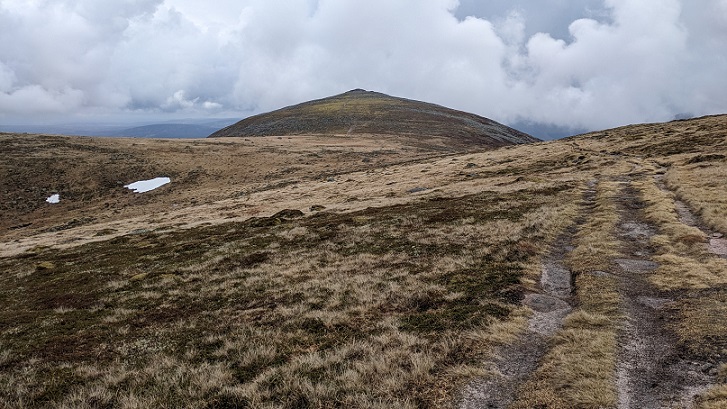
The availability of food is further limited by the presence of rocky ground over significant parts of Bachnagairn, including around the summit of Broad Cairn and where the boundary slopes down to the Allt an Dubh Loch (middle left).
Yet, according to NatureScot’s response to my FOI request, just two year previously the deer density at Bachnagairn had been no less than 23 deer per square kilometre:
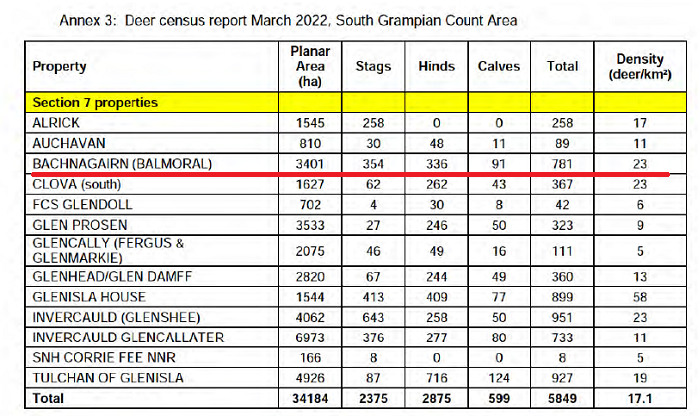 That figure suggests is that in the 21 years since the initial creation of the Section 7 Agreement at Caenlochan and two years after the scathing report of the Deer Working Group (see here) the Royal Family had done nothing to reduce deer numbers on Bachnagairn. Indeed deer density in 2022 was higher than it had been in 2019:
That figure suggests is that in the 21 years since the initial creation of the Section 7 Agreement at Caenlochan and two years after the scathing report of the Deer Working Group (see here) the Royal Family had done nothing to reduce deer numbers on Bachnagairn. Indeed deer density in 2022 was higher than it had been in 2019:

Despite this evidence, Balmoral appears to have been in denial about the number of deer on Bachnagairn and was even opposed to the renewal of the Section 7 agreement, which NatureScot had allowed to lapse in June 2020 (see here) but which had been called for by other landowners in the area:
“Balmoral – DS presented on behalf of Richard Gledson [the factor who gave his apologies for the meeting] stating that Balmoral had felt frustrated and disappointed to still be in this position, and being expected to be part of the Section 7 area. Balmoral had accepted that it was most likely that they would sign the Section 7 Agreement, but that was against a backdrop where the Estate can demonstrate both a deer density of around 8 to 8.5 deer per km2 across the whole Estate, and also HIA data, showing an improving quality in habitat. CW [from Bachnagairn] added that significant public access continues to displace deer concentrating their grazing patterns. He stressed that some particular habitats and flora are thriving and in very good condition. His concerns surrounded displacement of deer due to the public, and also the significant storm damage to woodlands. (Extract from Minutes of SGDMG meeting with Nature Scot about the new Section 7 agreement 21st October 2022 – from the SGDMG website)
It should come as no surprise that the Royal Family don’t want to be subject to the same rules, not even when it concerns minimal measures to reduce the destruction of the natural environment, as everyone else. IF Balmoral have reduced deer to 8-8.5 per km on average across the whole of the estate (which would fit with the natural regeneration I saw along Loch Muick) why have they not made this information publicly available, as happens in other Deer Management Groups? They could have easily made this happen if they supported the SDNADMG website but instead appear to have been have been happy to allow it to fall into disuse.
As explained in my post on what deer density means in practice (see here), in averaging out deer numbers for the whole estate Mr Gledson has ignored the fact that deer are excluded from large areas by fencing, while amount of feed available elsewhere is limited by muirburn. The result is that average deer density on the open hill for much of Balmoral will be well over 10 per square km, NatureScot’s upper limit for the uplands, as is evidenced by the counts for Bachnagairn.
In attempting to blame visitors for the presence of large numbers of deer in sensitive areas, CW failed to explain why herds of deer graze so close to the Spittal of Glen Muick car park, the most popular access point for walkers to Balmoral. In my view that claim was an ineffective attempt to deflect responsibility away from the estate.
The South Grampian DMG website (see here), in contrast to the SDNADMG website, has been very efficiently administered since 2022, publishing minutes of meetings and – after my FOI request to NatureScot – some background information too. This transparency is welcome – an interesting question is whether this is because the group is not dominated by royal sporting interests? Interestingly too, the minutes shows that Balmoral/Bachnagairn have not been the best attenders at the SGDMG meetings, being absent from the meeting on 25th January 2023 where the revised Section 7 agreement was signed off and from the most recent meeting on 5th November 2024 where the recent stag cull was reported to be about 100 below target. Unfortunately, the minute did not record which estates had culled less than their target but, wherever responsibility for this lies, at a time when leadership is needed to keep up the momentum to reduce deer numbers at Caenlochan, Balmoral was conspicuous by its absence..
Deer impacts in the upper reaches of Glen Muick and the north side of the loch
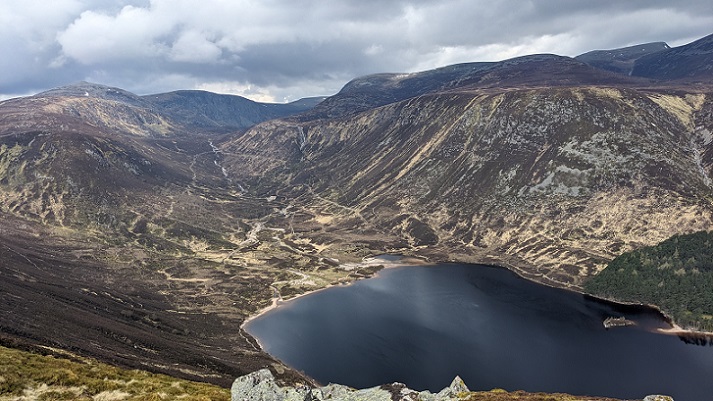
The rain started to tip down as we descended from Cairn Bannoch to the floor of the glen above the Dubh Loch and left Bachnagairn. As a consequence we saw very little but there was no reason to believe that deer density here was any less than that recorded at Bachnagairn. The bare hillsides and the large new native woodland enclosure told a tale.
The rain relented somewhat as we approached Glas Allt Shiel and the state of the policy woodland around the lodge provided some further easy to see evidence of grazing pressure:
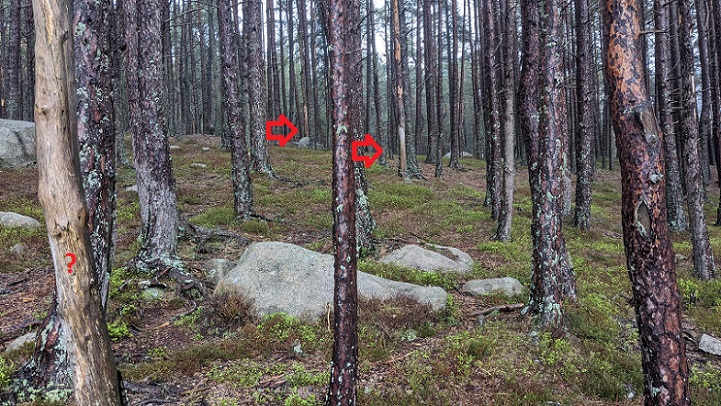
We then passed further woodland enclosures along the north shore of Loch Muick, which provided a good example of all that is wrong with woodland conservation in Scotland but which I will consider in a further post.
A right royal mess
This post has shown that the Royal Family, now headed by King Charles, have for over 20 years failed to co-operate with NatureScot’s attempts to use the voluntary provisions contained in Section 7 of the Deer (Scotland) Act 1996 to reduce the extremely high number of red deer at Bachnagairn on what used to be – and should be – a nature reserve and is still designated a Special Area of Conservation. It has also shown that deer numbers on the open hill on the main part of Balmoral are likely to be far higher than 8-8.5 per square kilometre.
The Royal Family continue to put their sporting interests above all else when it comes to managing their own land in Scotland. The evidence shows they see maintaining high numbers of deer and grouse to shoot as being far more important than tackling the nature and climate crises at a landscape scale.
The various conservation initiatives at Balmoral – which I will consider further in another post – are dwarfed by the failure to reduce deer numbers to the sustainable level of two or less per square kilometre. The evidence from Glen Feshie and Mar Lodge (see here) shows an average of 8 deer per square kilometre is four times higher than what would be necessary for the land at Balmoral to regenerate naturally.
The real problem is that NatureScot’s target deer density of 10 per square km is far too high and plays into the hands of sporting interests. One of the consequences at Balmoral is the native pinewood at Ballochbuie, one of the last refuges for the capercaillie, has no chance of expanding beyond its killer fencing (see here). Whether or not Balmoral or the other estates covered by the Section 7 Agreement at Caenlochan reach that target deer density by 2026, as NatureScot claimed they were on course to do earlier this year, is irrelevant: there is no chance of the land recovering until deer densities are much much lower than that.
One need look no further than Bachnagairn and Balmoral to understand the failures of deer management in Scotland since the creation of the Scottish Parliament. Just like in Victorian times, where the Royal Family lead, most other sporting estate landowners follow. Why, when the Royal Family fail to act and get away with it, as at Bachnagairn, would any other sporting landowner take reducing deer density seriously?
Most MSPs appear completely unaware that one of the recommendations of the Deer Working Group was that the Scottish Parliament should investigate why NatureScot’s Section 7 agreement at Caenlochan had failed year after year and why NatureScot failed to use its compulsory powers. The Royal Family’s management of Balmoral should be central to that and a parliamentary inquiry needs to happen BEFORE the Scottish Government introduces any new legislation to control deer numbers.
MSPs could also usefully ask why the Cairngorms National Park Authority has failed to speak out about this scandal but instead has been bunging more public subsidies (see here) to one of the richest landowners in the country.
If you have not watched it Channel 4’s Dispatches programme on the large amounts of private income the Royal Family raise from the Duchies of Cornwall and Lancaster it is well worth viewing (see here). King Charles could easily afford to manage Balmoral for conservation purposes, following the example of the NTS and the estates in Cairngorm Connect, while continuing to stalk some deer and shoot some grouse but that would mean accepting smaller game bags. Its the number of birds and animals that are available to be shot year after year which drives Balmorality.

The 10 deer per km2 was never intended as a target, but was recommended by the Deer Working Group as an upper limit on densities in large upland areas. That was an initial recommendation and was to be kept under review. It was the Association of Deer Management Groups that repeatedly described it as a target, and that seems to have stuck.
Increasingly it is possible to count deer over large areas with drones using thermal imaging. Such counts are finding significantly higher densities of deer than helicopter or foot counts. Among other things drone counts allow deer to be counted in open canopy woodland. These areas are never counted even in expensive helicopter counts which are usually done in early spring when cold weather usually means there will be many deer down in any woodlands they can get into. All of this rather renders the cull plans and population models that deer management groups have been following dead letter.
Recommendation 86
The Working Group recommends that Scottish Natural Heritage should adopt 10 red deer per square kilometre as an upper limit for acceptable densities of red deer over large areas of open range in the Highlands, and review that figure from time to time in the light of developments in public policies, including climate change measures
Hi Henry,
You are absolutely right about the report of the DWG saying 10 deer per square km was the upper limit and apologies for my language being so loose. Unfortunately, it is not just ADMG that has changed this to a target but NatureScot – clearly the upper limit of 10 deer per sq km is NOT appropriate for a Special Area of Conservation and what was once a National Nature Reserve. Your point on drones and thermal imaging is absolutely right. Deer are very very hard to see and their numbers constantly underestimated – King Charles could show a lead and use this technology to provide accurate reports on deer numbers at Balmoral!
perhaps the new/forthcoming duty to agree estate land management plans will help here?
rather than set a somewhat arbitrary deer density, instead agree the proposed outcome for a particular patch of land.
then, landowners/managers free to apply/adopt appropriate measures to deliver the outcome.
As secretary of South Grampian DMG, I can report to you that the Caenlochan Section 7 reduction cull is progressing well at the moment, with Nature Scot staff liaising with all estate stalkers within the area on a weekly basis to monitor and report on progress. The 2023-24 cull (last season) was well above target, and when combined with a lower recruitment in 2024, means that the target density might actually be achieved by spring 2025, a year ahead of schedule. The population will be counted at that stage to check, but regardless, there is no reason to suspect that target density cannot be achieved by spring 2026 as per agreement, with the majority of reduction culling already complete. You note the stag cull is 100 below target this year, but as the minutes state, there is no longer a stag season, and several members are likely to make up or surpass that 100 animals by the end of the season, and deliver the hind cull which is more important, with Nature Scot happy with progress to date over the past month or so. I have seen the figures to 25th November, which have moved things on from the 5th November minutes that you reference, this month being the key one for getting numbers.
On a general point, it is important to not read things in to minutes that are not there. The practical arrangements in place mean that DMG attendance is not imperative if apologies are warranted, for whatever reason. It is the case that almost everyone associated with Caenlochan, including agency staff, are fed up with the whole thing after 20 years. For this reason, we are currently looking at options for directing management beyond the Section 7 process, so that everyone can determine better what success looks like. We have support from Nature Scot and CNPA in the approach we hope to take to that, which we are scoping out at the moment.
As you note in your article, we are trying to be transparent in our communications, but will not be giving a running commentary. There is information on our website which outlines the practical reasons why Caenlochan is proving to be difficult, even with goodwill and full participation by all members at present. The red deer population around Caenlochan is very mobile (this being part of the problem), so a property by property breakdown of figures would be misleading and could be interpreted incorrectly. Balmoral/ Bachnagairn are participating fully as they are required to do. What happens this winter, including any spring count, will be reported and be in the public domain at the end of the season. That too will be on our website, with no need to FOI Nature Scot to get it.
Hi Victor, as I said in my post the transparency with which the SGDMG has been operating is welcome and your response proves that. Thanks for the update and no, I won’t be giving a running commentary on the minutes though I will be watching to see what happens and what NatureScot and CNPA do when deer density reaches the “upper limit” of 10 per sq km. Nick
Our local DMG had a new website(around 2017) with fine intentions running through it. However the latest minutes are dated 2019 and no update of news,members or officials has been carried out since then. Hardly an inspiring example of how estates and differing interests are cooperating in local deer management.
Excellent analysis Nick…highlighting the smoke and mirrors being employed in ‘deer world’ by estates and Nature Scot.
An agency that has been well and truly captured by the landowners. It is therefore obvious that a great deal more clarity and precision is required if we are to manage deer sustainably. Currently there is far too much wriggle room for estate owners and their spokespeople to suggest progress is being made under the light touch voluntary approach of Nature Scot. The only way to protect the public interestin my opinion is a legal requirement for estates of a certain size to produce deer management plans that detail cull levels and the expected outcome of those plans. The culls should be mandatory, and reviwed regularly to reflect outcomes on the ground